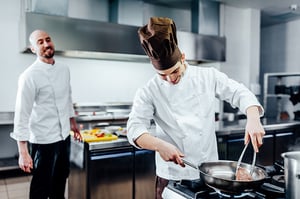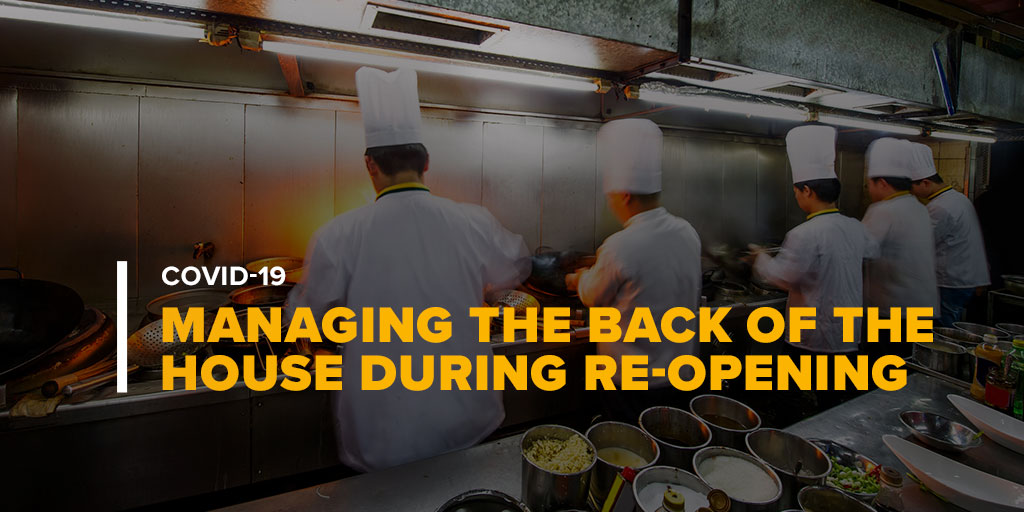#5 in the "Restaurants Post-COVID-19" series. In previous posts in this series, we looked at the front-of-house operations for an initial glimpse at restaurants in the post COVID-19 environment. Today, we focus on the specific considerations that should be given to the back of house and the staff who work on that side of the restaurant. More specifically, we will discuss how a 250-seat restaurant may have been staffed in the past and how, under the present circumstances, it should be staffed moving forward.
Pre-pandemic, a 250-seat restaurant probably would have employed roughly 50 people in the back of house, including the kitchen staff, stewards, porters, and receivers. This small army probably worked in tight quarters and seamlessly shared space utilizing the same tools, left handwritten notes with prep lists, shared family meal together, and did many other things that are not aligned with employee safety recommendations for post-COVID operations.
As restauranteurs start to reopen their businesses, the kitchen is going to present some unique challenges. We mentioned above a very common aspect of kitchen interaction that needs to be addressed: communication of prep lists between the different shifts. A simple option is to purchase a white board, post it in a common area of the kitchen, and distribute dry erase markers to every member of the kitchen staff and use the board for communications. Information can be easily conveyed in this way and giving every cook his or her own marker is a cost-effective way to operate safely.
A more challenging issue is the fact that social distancing is nearly impossible in many kitchens. While a larger restaurant has more overall space, that larger space is usually staffed by more people to keep up with the higher demand, which means space is often still at a premium. Menu engineering will be critical. Proper attention, not only to the items on the menu but also the required food preparation for those items, is necessary to allow for greater social distancing.
Staggering staff arrival times can also help kitchens practice social distancing, yet function with a semblance of normalcy because it allows for smaller teams of people in the space. This will also put a greater emphasis on communication in a kitchen because as teams rotate in and out, team members coming in later will need to pick up where another left off. Kitchens may also want to consider creating a system of specific groups that work together consistently, so contact can be easily traced if a team member becomes ill.
A schedule that employs these groupings, will not only allow the same people to work together and develop their own systems but can mitigate the potential of illness transfer. For example, if one of the four members of your 10 AM shift presents with symptoms, you can pull all members of that shift and replace just those impacted members while continuing operations with minimal disruption.
This model may work better in a larger restaurant with a larger kitchen staff to draw from, but there are ways for a smaller operation to set up minimum staff groups and then add staff as business increases. This approach can keep a core production team together and, with the right technology, schedule staff more efficiently while accounting for the personal needs of each team member.
Other schedule configurations may also be needed in the early days of re-opening. Rotating shifts of 10 hours in length, four and then three days a week is an approach we have recommended to a number of clients. These shifts can be alternated to ensure that hours are being evenly distributed. Additionally, depending upon operating hours, 12-hour shifts can also be useful. This limits the number of different staff interactions during operating hours. It may also prove to be helpful to staff who have childcare, elder care or other external issues, because it enables them to be home full days each week consistently. Clearly overtime laws have to be adhered to on a state-by-state basis, but re-thinking traditional scheduling assumptions is one strategy restaurants will need for success in this environment.
 There will not be a one-size-fits-all solution that works for every kitchen; you will have to experiment to determine what works best for your specific kitchen. Part of this experimentation will come about naturally when it is time to reopen.
There will not be a one-size-fits-all solution that works for every kitchen; you will have to experiment to determine what works best for your specific kitchen. Part of this experimentation will come about naturally when it is time to reopen.
You can test your ideas by treating this time as though you are opening your restaurant for the first time, and part of that process should include mock service. A mock service will help your front staff, but also be incredibly important for your kitchen staff to familiarize themselves with new routines.
These new routines that include staggered in-times for staff will mean periods of time when your coverage on the line is lighter and cooks will have to make sure they are setting themselves up for success regardless of the number of cooks. Cross-training team members as you prepare to reopen will pay significant dividends as your operations open and slowly increase business volumes. We have seen with restaurants that have already begun to reopen in parts of the country that business volumes fluctuate unpredictably, and cross-training has been critical to getting kitchens staffed when business is unexpectedly heavy.
It is a well-loved tradition in many restaurants for the staff to gather before service for family meal which is usually served buffet style, with staff serving themselves using the same utensils. Social distancing will require this approach to change. While some restaurants may do away with it entirely, many municipalities require some type of staff meal. Smaller restaurants could allow their staffs to order food off the menu, but this quickly becomes expensive and negatively impacts food cost percentages. A model of this sort would probably be unthinkable in a larger restaurant.
There are a number of alternatives to addressing this. You might provide staff with three or four menu options for a plated meal, allowing no substitutions. Another option would be to maintain a buffet-style family meal with one cook serving – and obviously wearing the proper PPE’s. This alternative makes social distancing more challenging and available space for staff to distance when eating at the same time will be a consideration for management.
Clearly there are many things to consider, and no easy answers for the challenges we face today. You will need to take things slowly and understand that the principal axiom of restaurants has not changed: there are things outside of your control than you cannot plan for, but it is how you deal with those bumps in the road that truly test your mettle.
We all hope for a return to normalcy as quickly as possible, but the fact remains that it will be quite some time before that is once again a reality and even more likely, there will be a “new normal”. In the interim, we must be cognizant of the factors we are unable to control while focusing on the things that we can.
Read the other articles in the series:
- #1: Operating Restaurants in a COVID-19 Environment
- #2: Pre-Opening Considerations for Restaurants in a COVID-19 Environment
- #3: Menu Engineering and Planning
- #4: Taking Full Advantage of Available Demand with Post COVID-19 Restricted Restaurant Capacity
- #5: Managing the Back of the House in Post-COVID-19 Re-Opening
- #6: Operating in the New COVID-19 Normal
Know someone trying to solve their workforce management problems? Share this post them! Or, if you have questions comments, leave them below.






